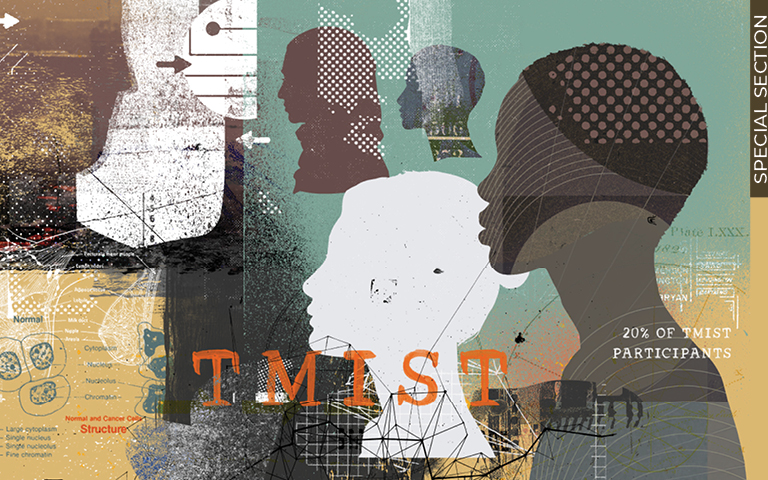“The ultimate goal of the Tomosynthesis Mammographic Imaging Screening Trial (TMIST) is to individualize screening and bring the right tests to patients. We have had a one-size-fits-all strategy since screening came to being in the ‘60s and ‘70s. It has been mammography, versus nothing, for many women,” says Etta D. Pisano, MD, FACR, chief research officer for the ACR Center for Research and Innovation™ (CRI), adjunct professor of radiology at the University of Pennsylvania, and TMIST study chair.
TMIST is a large, National Cancer Institute-funded and ECOG-ACRIN-sponsored randomized phase III study that is evaluating the ability of 3D mammography to find more of the aggressive types of cancers likely to kill women, comparing it to digital mammography. TMIST will help determine how best to use both of these technologies in the future.1
TMIST is a health equity bright spot — with around 21% of the American women enrolled in TMIST identifying as Black, which is more than double the average Black cohort in National Cancer Institute trials. ACR’s CRI has been working with the National Medical Association and other advocacy groups to help identify sites serving diverse populations and ask them to participate in the study. In addition, TMIST provides a fund to pay for screening mammograms for patients who qualify.
“We thank those new sites coming on board at a very exciting time in this landmark study,” says Pisano. “TMIST continues to be among the fastest-growing clinical trials of the COVID-19 era due to the dedication of site staff and local investigators — and we look forward to working together to further advance breast cancer screening.”
INDIVIDUALIZING PATIENTS
TMIST is the first randomized controlled trial with the goal of determining whether digital breast tomosynthesis (DBT) outperforms 2D digital mammography in reducing advanced breast cancers in the population being screened. “We have been really great about improving and individualizing therapies for breast cancer. With this trial, we are hoping to provide recommendations that individualize screening strategies — based on many factors, including the unique genetics of the women being screened,” Pisano says.
To do this, TMIST includes a biorepository, Pisano says, collecting blood and saliva from women to look at their DNA. “We are studying the relationship between developing tumors and women’s unique genetics. Participating sites are recruiting patients to help us answer important questions,” she says. “The findings not only impact women getting screened now, but also our daughters and granddaughters.”
The study overall has been successful, Pisano says, because participating sites are committed to it. “They care about learning more about mammography and about screening in general.”
I think TMIST has the potential to enhance the participation of minority communities everywhere — we're getting the word out and interested sites are flowing in.
AMBITIOUS TRIAL
TMIST aims to create the world’s largest curated dataset of breast cancer screening clinical data, images, and bio-specimens to help researchers tailor future screening to a woman’s individual risk.
TMIST will ultimately enroll 128,905 healthy women ages 45 to 74 at 130 sites throughout the world, with sites currently open in the U.S., Canada, Argentina, Peru, Italy, and South Korea.
Participating sites must have both DBT and digital mammography equipment. TMIST sites must also be a member of one of the National Clinical Trials Network’s groups, such as ECOG-ACRIN or the National Community Oncology Research Program.
“TMIST is the type of study that will add tremendously to the literature regarding mammography,” says Edith P. Mitchell, MD, a practicing medical oncologist at Thomas Jefferson University Hospital in Philadelphia and co-chair of the ECOG-ACRIN Health Equity Committee. “I think TMIST has the potential to enhance the participation of minority communities everywhere — we’re getting the word out and interested sites are flowing in.”
The study allows radiologists to help evaluate how to best implement breast cancer screening, Mitchell says. “It provides an opportunity for the utilization of mammography, but also will give information regarding the biological aspects of breast healthcare, and therefore will contribute in multiple ways to our understanding of breast healthcare — not only for cancer, but for breast health in general,” she says.
Because women of color are often underrepresented in breast cancer screening trials, TMIST leaders and clinical staff are working hard to ensure racial, ethnic, and geographic diversity among volunteers so that the trial results apply to all women. The TMIST recruitment and patient materials are available in English, Spanish, Simplified Chinese, Korean, and Vietnamese.
TEAM EFFORT
“We are all working together. It’s a team effort,” Mitchell says of ACR’s leadership around the TMIST study. “We are trying to reach as many individuals as possible through the ECOG-ACRIN mechanism by encouraging participation of radiologists.”
“We also have patient advocates in the study — very intensely involved in contributing ideas — ensuring that the patient is incorporated into the TMIST strategy,” Mitchell says. “That means we are interested in all women, but especially those in communities where there has not been active participation in clinical trials.”2
LOCAL STRIDES
“We need more sites to take part, particularly those in underserved areas,” says Pisano. “We want to reach more women in local communities, especially women of color, to gain a study population
so that the data we collect in the study are representative of all the types of women who seek screening services so that our results can move breast cancer screening and health equity forward.”
“I would love to have more sites that can recruit more Asian American and Pacific Islander women, for example,” Pisano says. “We also need sites that are serving Native American women.”
“The main reason we have been so successful at recruiting Black women for the study is because we are working with sites that are serving these women and their healthcare needs every day,” Pisano adds. “I think the secret of recruiting diverse populations is to open new sites that already work with and care for those women. Those women have to have trust in the site where they will be getting care.”

